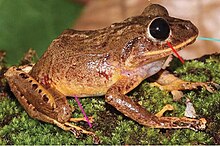
Atelopus is a large genus of Bufonidae, commonly known as harlequin frogs or toads, from Central and South America, ranging as far north as Costa Rica and as far south as Bolivia. Atelopus species are small, generally brightly colored, and diurnal. Most species are associated with mid-to-high elevation streams.

The Panamanian golden frog, also known as Cerro Campana stubfoot toad and other names, is a species of toad endemic to Panama. Panamanian golden frogs inhabit the streams along the mountainous slopes of the Cordilleran cloud forests of west-central Panama. While the IUCN lists it as Critically Endangered, it may in fact have been extinct in the wild since 2007. Individuals have been collected for breeding in captivity in a bid to preserve the species. The alternative common name, Zetek's golden frog, and the epithet zeteki both commemorate the entomologist James Zetek.
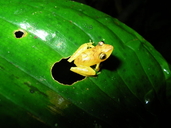
Pristimantis caryophyllaceus is a species of frog in the family Strabomantidae. It is found in Costa Rica and Panama; records from Colombia prior to 2010 refer to Pristimantis educatoris. However, taxonomy of Pristimantis caryophyllaceus and P. educatoris remain unsettled, and many sources continue to report Pristimantis caryophyllaceus from Colombia.
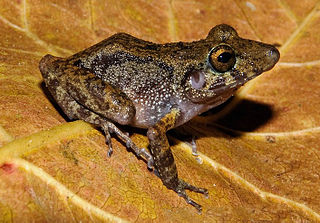
Pristimantis gaigei, also known as the Fort Randolph robber frog or Gaige's rain frog, is a species of frog in the family Strabomantidae. It is found in the Atlantic drainage lowlands from extreme south-eastern Costa Rica to eastern Panama and to central Colombia; it is widely distributed in Colombia west of the Cordillera Oriental. Its natural habitat is primary humid lowland forest, but it also occurs in secondary forest. It is a nocturnal species found under surface debris and in leaf-litter.
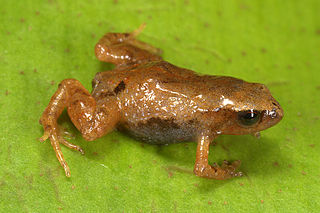
The Strabomantidae are a family of frogs native to South America. These frogs lack a free-living larval stage and hatch directly into miniature "froglets". This family includes Pristimantis, the most speciose genus of any vertebrate.

Ecnomiohyla rabborum, commonly known as Rabbs' fringe-limbed treefrog, is a possibly extinct species of frog in the family Hylidae. They were relatively large frogs that inhabited the forest canopies of central Panama. Like other members of the genus Ecnomiohyla, they were capable of gliding by spreading their enormous and fully webbed hands and feet during descent. The males of the species were highly territorial and would guard water-filled tree holes used for breeding. They were also the ones responsible for guarding and caring for the young, including providing food. They were the only known species of frog where the tadpoles derived nutrition by feeding on the skin cells of their fathers.

Diasporus is a genus of frogs in the family Eleutherodactylidae. The genus was first described in 2008. They are found in Central and northern South America. They are sometimes referred to as dink frogs, in reference to the "tink" sound that males make during the mating season.
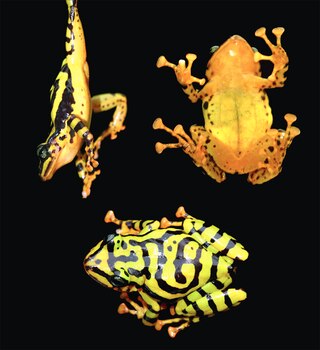
Pristimantis ecuadorensis, also known as Ecuadorian rainfrog, is a species of rainfrog in the family Strabomantidae that is endemic to Ecuador. It is only known from three nearby localities on the western slopes of the Ecuadorian Andes in the Cotopaxi and Pichincha Provinces. Prior to its description as a new species in 2017, it was mixed with Pristimantis ornatissimus. As currently defined, Pristimantis ornatissimus occurs at elevations below 1,100 m (3,600 ft), whereas Pristimantis ecuadorensis is known from 1,450–1,480 m (4,760–4,860 ft) above sea level.

Greta Tintin Eleonora Ernman Thunberg is a Swedish environmental activist known for challenging world leaders to take immediate action for climate change mitigation.
Lepidoblepharis rufigularis is a species of gecko, a lizard in the family Sphaerodactylidae. The species is endemic to Panama.
Lepidoblepharis victormartinezi is a species of gecko, a lizard in the family Sphaerodactylidae. The species is endemic to Panama.
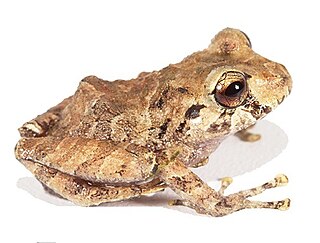
Pristimantis mallii is a species of frog in the family Strabomantidae. It is endemic to Ecuador. Described in 2019, it is only known from the Río Zuñag Reserve on the eastern slope of the Andes, in the upper basin of the Pastaza River. The specific name mallii honors V. N. Mallikarjuna "Malli" Rao, winner of Lavoisier Medal who helped develop an environmentally safe alternative to the fluorocarbons and whose donation helped establish the Río Zuñag Reserve. Common name Malli's rain frog has been coined for this species.
Climate activist Greta Thunberg made a double crossing of the Atlantic Ocean in 2019 to attend climate conferences in New York City and, until it was moved, Santiago, Chile. She sailed from Plymouth, UK, to New York, United States aboard the racing yacht Malizia II, returning from Hampton, Virginia, to Lisbon on the catamaran La Vagabonde. Thunberg refuses to fly because of the carbon emissions of the airline industry and the trip was announced as carbon neutral. As a racing sailboat, the Malizia II has no toilet, fixed shower, cooking facilities or proper beds.
Ecnomiohyla bailarina, the golden-eyed fringe-limbed tree frog, is a frog in the family Hylidae, endemic to Panama and Costa Rica. Scientists have seen it between 400 and 1400 meters above sea level. It lives in the Talamanca Mountains in Costa Rica and in Santa Fé National Park in Panama.
Ecnomiohyla veraguensis is a frog that lives in Costa Rica and Panama. Scientists have seen it at 540 meters above sea level. It lives in the Talamanca Mountains in Costa Rica and in Santa Fé National Park in Panama.

Opacuincola gretathunbergae is a freshwater snail endemic to New Zealand. It is named after the climate activist Greta Thunberg.

The Climate Book is a collective non-fiction book by the climate activist Greta Thunberg. The original English edition was published in October 2022. Translations are published in languages including German, Spanish, Portuguese, Italian, French, Dutch, Swedish, Danish, Norwegian, and Polish.
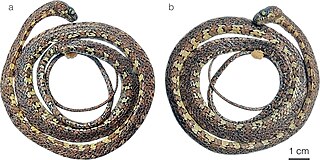
Sibon irmelindicaprioae is a species of nonvenomous snake in the subfamily Dipsadinae. It is endemic to Panama. It was discovered by Ecuadorian biologist Alejandro Arteaga and Panamanian biologist Abel Batista in 2023. Sibon irmelindicaprioae belongs to the genus Sibon, and subfamily Dipsadinae. It is also called DiCaprio’s snail-eating snake.
